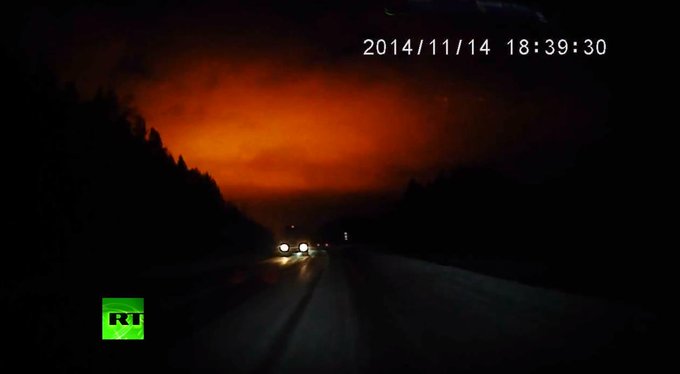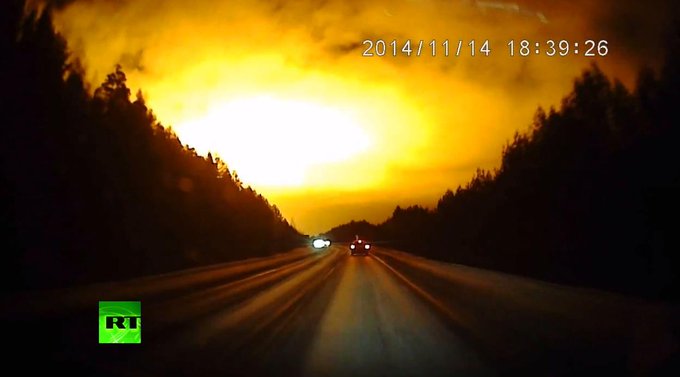|
Cahaya Misteri Terangi Tengah Malam Bandar Rezh Di Rusia MOSCOW – Satu cahaya cerah berwarna oren yang muncul selama 11 saat di bandar Rezh dekat sini mencetuskan misteri dalam kalangan penduduk setempat. Cahaya berkenaan berjaya dirakam oleh sebuah kamera video milik seorang pemandu kereta pada Jumaat lalu yang menunjukkan langit yang gelap ketika itu tiba-tiba menjadi terang seperti waktu siang selama beberapa saat. Lelaki tersebut berkata, ketika kejadian dia dalam perjalanan pulang ke Rezh sebelum satu cahaya terang tiba-tiba muncul di bandar berkenaan. “Cahaya itu sungguh terang sehingga menyebabkan keadaan yang gelap ketika itu menjadi cerah seperti waktu siang,” katanya. Sementara itu, akhbar The Siberian Times melaporkan bahawa beberapa pakar mengesyaki cahaya tersebut mungkin berpunca daripada pelancaran peluru berpandu atau sebuah tahi bintang yang jatuh ke bumi. Bagaimanapun, saksi yang melihat kejadian berkenaan tidak mendengar sebarang bunyi dan pihak berkuasa Rusia juga enggan memberikan sebarang komen.
|
stania83 posted on 20-11-2014 09:39 AM
Yg pelik pelik salu kat Russia. Depa letopkan uranium kat space kot.

sassy_girl82 posted on 20-11-2014 09:42 AM
mcm2 kejadian misteri berlaku skgni..
tak termasuk kisah pocong di teluk intan

d'zeck posted on 20-11-2014 09:44 AM
banyak lagi rahsia keajaiban
alam yang belum diketahui makhluk manusia,

ResellerMaxis posted on 20-11-2014 09:48 AM
alam dah wujud billion tahun..kepakaran teknologi kita belum seratus tahun lagi..mungkin fenomena ...




Looks like a falling bolide, which invaded us. Because of the low cloud cover it ceased to exist above the clouds and lit up the whole sky.
tentera_laut posted on 20-11-2014 09:52 AM
setuju ngan kau..
usia alam semesta ini lebih kurang 2 billion tahun.



ResellerMaxis posted on 20-11-2014 09:58 AM
apakah aurora tu??
aku tahu aurora jet dalam game command and conquer jer..
Apa itu Aurora?
Dipanjangkan di sini maklumat mengenai aurora untuk dikongsi bersama…..
Solar storm hitting Earth causes spectacular aurora displaysA large solar storm has caused spectacular aurora displays across the Northern Hemisphere after blasting out of the Sun three days ago.On August 1, almost the entire side of the Sun that faces the Earth erupted in a blaze of activity known as a “coronal mass ejection”. These storms throw up to 10 billion tons of plasma – superheated gas – off the surface of the star and hurtling into space at around a million miles an hour. It covered the 93 million mile journey from the Sun to the Earth in just three and a half days.It was the “first major Earth-directed eruption in quite some time,” according to Leon Golub, a scientist at the Harvard-Smithsonian Center for Astrophysics (CfA), who warned of the event on Monday.The flare which caused the eruption was relatively small, described as a class C3 by astronomers. Other flares, known as X or M class, are much larger, and capable of doing damage on Earth. C-class flares rarely have much effect on Earth beyond auroras – the glowing displays towards the poles, like the Northern (and Southern) Lights.Dramatic auroras were seen in Denmark, Norway, Greenland, Germany and across the northern United States and Canada as the expanding bubble of gas slammed into the Earth’s atmosphere. The frequently beautiful displays are caused by the charged particles in the plasma interacting with the Earth’s magnetic field – the solar matter is drawn towards the poles, where they collide with nitrogen and oxygen atoms in the atmosphere.While no damage seems to have been done by this flare, Nasa astronomers have previously warned that a much larger solar storm could cause havoc with electrical systems on Earth. In 2013, the Sun is expected to reach a stage in its roughly 11-year cycle when large storms are more likely.In 1859, one huge flare burned out telegraph wires across Europe and the USA. The so-called “Carrington flare”, named after its discoverer, “smothered two-thirds of the Earth’s skies in a blood-red aurora a night later, and crippled all global navigation and global communication, such as it was at that time. Compasses spun uselessly and the telegraph network went down as phantom electricity surged through the wire,” according to Dr Stuart Clark, author of The Sun Kings.More recently, in 1989, a smaller but still enormous storm caused the power grids in Quebec to go down for nine hours, causing hundreds of millions’ worth of dollars in lost revenue.
Solar flares, coronal mass ejections and aurora borealis in pictures:
 In this X-ray photo provided by NASA, the sun is shown early in the morning of Sunday, August 1, 2010. The dark arc near the top right edge of the image is a filament of plasma blasting off the surface – part of the coronal mass ejection. The bright region is an unassociated solar flare. When particles from the eruption reach Earth on the evening of August 3-4, they may trigger a brilliant auroral display known as the Northern Lights ~ Picture: AP / NASA
In this X-ray photo provided by NASA, the sun is shown early in the morning of Sunday, August 1, 2010. The dark arc near the top right edge of the image is a filament of plasma blasting off the surface – part of the coronal mass ejection. The bright region is an unassociated solar flare. When particles from the eruption reach Earth on the evening of August 3-4, they may trigger a brilliant auroral display known as the Northern Lights ~ Picture: AP / NASA
 This still from an April 12-13 video recorded by NASA’s new Solar Dynamics Observatory (SDO) shows an eruptive prominence blasting away from the sun. The prominence appears to stretch almost halfway across the sun, about 500,000 miles ~ Picture: AP / NASA
This still from an April 12-13 video recorded by NASA’s new Solar Dynamics Observatory (SDO) shows an eruptive prominence blasting away from the sun. The prominence appears to stretch almost halfway across the sun, about 500,000 miles ~ Picture: AP / NASA
 A full-disk multiwavelength extreme ultraviolet image of the sun taken by the Solar Dynamics Observatory on March 30. False colours trace different gas temperatures. Reds are relatively cool (about 60,000 Kelvin, or 107,540 F); blues and greens are hotter (greater than 1 million Kelvin, or 1,799,540 F) ~ Picture: AP / NASA.
A full-disk multiwavelength extreme ultraviolet image of the sun taken by the Solar Dynamics Observatory on March 30. False colours trace different gas temperatures. Reds are relatively cool (about 60,000 Kelvin, or 107,540 F); blues and greens are hotter (greater than 1 million Kelvin, or 1,799,540 F) ~ Picture: AP / NASA.
 A prominence eruption captured by the Solar Dynamics Observatory on March 30, 2010 ~ Picture: NASA / Corbis.
A prominence eruption captured by the Solar Dynamics Observatory on March 30, 2010 ~ Picture: NASA / Corbis.
 A photo montage captured during a solar eclipse over the Marshall Islands in July 2009. The beautiful image shows the solar corona that makes up the sun’s atmosphere in amazing detail as the sun passes behind the moon ~ Picture: Miloslav Druckmuller / SWNS
A photo montage captured during a solar eclipse over the Marshall Islands in July 2009. The beautiful image shows the solar corona that makes up the sun’s atmosphere in amazing detail as the sun passes behind the moon ~ Picture: Miloslav Druckmuller / SWNS
 The whorls and loops of the corona extend millions of miles into space, are nearly 200 times hotter than the visible surface of the sun, and yet aren’t nearly as bright and hence can only be seen during eclipses ~ Picture: Miloslav Druckmuller / SWNS
The whorls and loops of the corona extend millions of miles into space, are nearly 200 times hotter than the visible surface of the sun, and yet aren’t nearly as bright and hence can only be seen during eclipses ~ Picture: Miloslav Druckmuller / SWNS
 A total solar eclipse, showing solar flares and prominences past the limb of the Sun, which is blocked by the Moon, and the solar corona. This eclipse took place during a maximum of a sunspot cycle, and the image is processed to show not only the corona but also the chromosphere and the prominences ~ Picture: Jay Pasachoff/Science Faction/Corbis
A total solar eclipse, showing solar flares and prominences past the limb of the Sun, which is blocked by the Moon, and the solar corona. This eclipse took place during a maximum of a sunspot cycle, and the image is processed to show not only the corona but also the chromosphere and the prominences ~ Picture: Jay Pasachoff/Science Faction/Corbis
 Composite image of the sun from the SOHO (Solar and Heliospheric Observatory) satellite. Images were taken at three different wavelengths, colour-coded and combined ~ Picture: NASA-ESA- digital version copyri/Science Faction/Corbis
Composite image of the sun from the SOHO (Solar and Heliospheric Observatory) satellite. Images were taken at three different wavelengths, colour-coded and combined ~ Picture: NASA-ESA- digital version copyri/Science Faction/Corbis
 Two active regions glow brightly in this ultraviolet image of the Sun. A small flare rises from the active area on the left. Flares are intense explosions on the Sun that blast radiation into space. This one paints a white line across the left horizon of the Sun. The active area on the right churns with magnetic loops. Arcs of charged particles rise from the surface and are drawn back down again in the magnetic field. Magnetic storms bombard Earth with charged particles that can interfere with electronics systems and satellites ~ Picture: NASA / Corbis
Two active regions glow brightly in this ultraviolet image of the Sun. A small flare rises from the active area on the left. Flares are intense explosions on the Sun that blast radiation into space. This one paints a white line across the left horizon of the Sun. The active area on the right churns with magnetic loops. Arcs of charged particles rise from the surface and are drawn back down again in the magnetic field. Magnetic storms bombard Earth with charged particles that can interfere with electronics systems and satellites ~ Picture: NASA / Corbis
ResellerMaxis posted on 20-11-2014 09:55 AM
walau macam mana pun..aku dapat bayang kan perasaan penduduk russia..tetengah malam..tetiba terang ...
ADVERTISEMENT